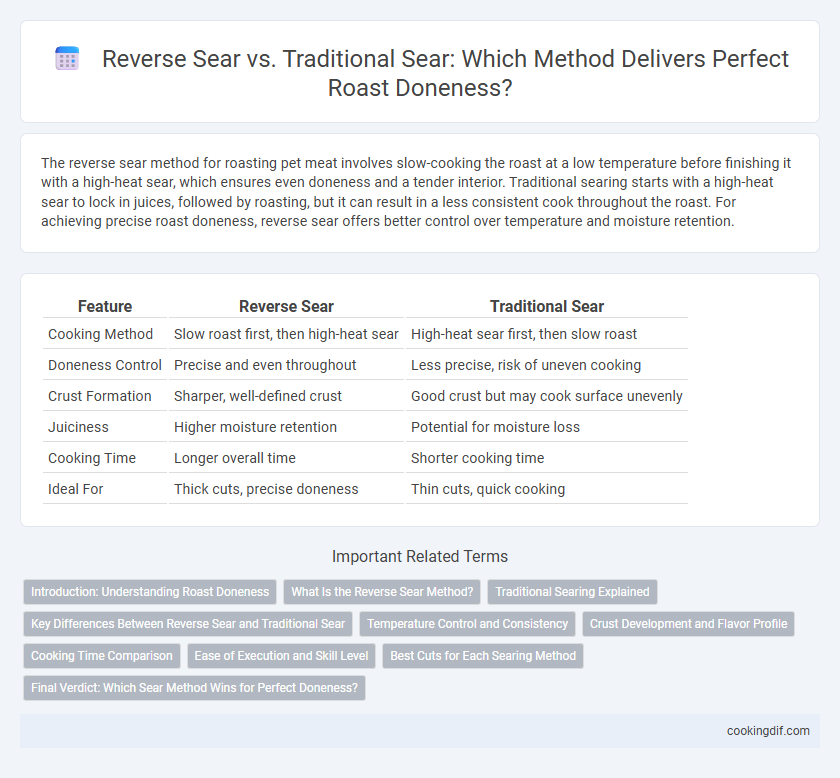The reverse sear method for roasting pet meat involves slow-cooking the roast at a low temperature before finishing it with a high-heat sear, which ensures even doneness and a tender interior. Traditional searing starts with a high-heat sear to lock in juices, followed by roasting, but it can result in a less consistent cook throughout the roast. For achieving precise roast doneness, reverse sear offers better control over temperature and moisture retention.
Table of Comparison
| Feature | Reverse Sear | Traditional Sear |
|---|---|---|
| Cooking Method | Slow roast first, then high-heat sear | High-heat sear first, then slow roast |
| Doneness Control | Precise and even throughout | Less precise, risk of uneven cooking |
| Crust Formation | Sharper, well-defined crust | Good crust but may cook surface unevenly |
| Juiciness | Higher moisture retention | Potential for moisture loss |
| Cooking Time | Longer overall time | Shorter cooking time |
| Ideal For | Thick cuts, precise doneness | Thin cuts, quick cooking |
Introduction: Understanding Roast Doneness
Roast doneness depends on precise temperature control and even cooking, which directly influence flavor and texture. Reverse searing gradually heats the meat to an optimal internal temperature before a final high-heat sear, enhancing juiciness and creating a uniform doneness edge-to-edge. Traditional searing starts with high heat to develop a crust, then finishes in the oven, often resulting in a more pronounced gradient of doneness from the exterior to the center.
What Is the Reverse Sear Method?
The reverse sear method involves slow-cooking the roast at a low temperature until it reaches the desired internal doneness, then finishing with a high-heat sear to create a flavorful crust. This technique ensures even cooking throughout the roast and a tender, juicy interior, avoiding the overcooked edges common in traditional searing. The reverse sear is especially effective for thick cuts such as prime rib or thick beef roasts, optimizing texture and flavor.
Traditional Searing Explained
Traditional searing involves cooking the roast at a high temperature initially to create a flavorful, caramelized crust while locking in juices. This method typically starts the roast searing on all sides in a hot pan before transferring it to the oven to finish cooking evenly to the desired doneness. Traditional sear is favored for its ability to develop rich Maillard reaction flavors and a visually appealing exterior on beef roasts.
Key Differences Between Reverse Sear and Traditional Sear
Reverse sear involves slow-cooking the roast at low temperature before finishing with a high-heat sear, while traditional sear starts with high-heat searing followed by roasting. Reverse sear offers more even internal doneness and better moisture retention compared to the faster, less uniform cooking of traditional sear. The key difference lies in temperature control and flavor development, where reverse sear enhances tenderness and a consistent crust without overcooking edges.
Temperature Control and Consistency
Reverse sear offers superior temperature control by slowly bringing the roast to the desired internal temperature before finishing with a high-heat sear, ensuring even doneness throughout. Traditional sear often risks uneven cooking as the high initial heat can create a crust but leave the interior over- or undercooked, making consistency challenging. Utilizing a reverse sear method enhances overall roast consistency by allowing the meat to cook uniformly before developing a flavorful, well-browned exterior.
Crust Development and Flavor Profile
Reverse sear enhances crust development by allowing gradual internal temperature rise, resulting in a thicker, more even Maillard crust compared to traditional sear methods. Traditional searing can produce a flavorful brown crust quickly but risks creating a gradient of doneness with less uniformity. Reverse sear's controlled cooking process intensifies flavor complexity and juice retention, offering a superior taste profile in roast doneness.
Cooking Time Comparison
Reverse sear method typically requires longer cooking time at a low temperature followed by a brief high-heat sear, ensuring even doneness and a consistent internal temperature throughout the roast. Traditional sear method involves a quick high-heat sear first, then transferring to a lower temperature oven, often resulting in faster overall cooking but less uniform doneness. Cooking time comparison shows reverse sear enhances control over final roast temperature, while traditional sear offers quicker preparation with potential for uneven cooking.
Ease of Execution and Skill Level
Reverse sear offers greater ease of execution by allowing a low, slow cook followed by a quick sear, which reduces the risk of overcooking and provides more control over roast doneness. Traditional sear requires higher skill to achieve a perfect crust without compromising the internal temperature, as it involves searing first and then roasting. For home cooks, reverse sear is generally more forgiving and accessible, while traditional sear favors experienced chefs aiming for precision.
Best Cuts for Each Searing Method
Reverse sear excels with thicker, bone-in cuts like prime rib or tomahawk ribeye, allowing even cooking before a final high-heat sear to develop a flavorful crust. Traditional sear works best for thinner cuts like sirloin or strip steak, where a quick, intense sear locks in juices and creates a caramelized exterior without overcooking. Choosing the right method based on cut thickness and fat content ensures optimal roast doneness and enhanced flavor profile.
Final Verdict: Which Sear Method Wins for Perfect Doneness?
Reverse sear consistently delivers more even doneness and juicier results by slowly bringing the roast to temperature before creating a crisp crust. Traditional sear often risks overcooking the outer layers while chasing a browned exterior, compromising internal texture. For flawless doneness with a tender, uniformly cooked center, reverse searing remains the superior method for roasting.
Reverse Sear vs Traditional Sear for roast doneness Infographic

 cookingdif.com
cookingdif.com